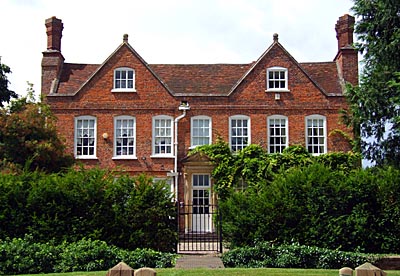 |
 |
|||
|
|
 Donnington Castle
House Donnington Castle
HouseDonnington, Berkshire In 1632, Donnington Castle had been purchased by John Packer of Shellingford Castle. During the 2nd Battle of Newbury in 1644, it was held for the King and received such severe damage that, three years later, it was described as "ruinous". However, the associated estate survived intact, along with the old steward's lodge which had not been quite so badly damaged. Having regained his Donnington property, Packer had the lodge rebuilt in 1648, using some materials from the old castle, although the house is essentially of brick. It then consisted only of the main entrance range, with two facing gables and flanking diamond chimneys. The two gables apparently once joined in the centre. The woodwork, including the fine staircase and some of the panelling, was undertaken by Richard Vesey of Westminster. The extensive eastern wings were added some time later. Packer died the following year and Donnington was left to his eldest son, Robert. He resided at Shellingford, but let his younger brother, William, occupy Donnington Castle House. He took a great interest in the Donnington Hospital. At the death of the brothers Packer, their heir, another Robert, was just a boy, so the estate was managed by a barrister named Michael Mallett. However, Robert's son, Winchcombe Howard Packer, favoured Donnington Castle House as his principal residence and received many of the chief wits and celebrities of the early 18th-century there: one of whom in a birthday-ode describes him as the "Patriot, generous and humane." The family had married a number of great heiresses though and inherited large properties at Little Sodbury Manor in Gloucestershire and Bucklebury House in Berkshire, so Donnington was moving still further down the list of their desirable residences. Winchcombe's sister and heiress, Elizabeth Packer and her husband, David Hartley, the famous physician and philosopher, did live at Donnington Castle House for a year in the mid-18th century. They considered making it their permanent residence, but in the end decided that they preferred London and Bath. From the 1790s, the house was rented out to tenants. The Bacon brothers appear to have both been in residence at some time. Anthony and Thomas Bushby Bacon were the illegitimate sons and joint-surviving heirs of the great Welsh ironmaster, Anthony Bacon, who made Merthyr Tydfil what it is today. They became two of the richest men in the country, but had no interest in their ironworks and sold them or rented them out. They became English country gentlemen in Berkshire instead. Anthony lived at Donnington Grove, then possibly Donnington Castle House. He moved to Benham Park in 1811, before retiring to Elcot Park in Kintbury in 1823. For twenty years, he was Commander of the Donnington Castle and Newbury Troop of the 1st Berkshire Cavalry. His son was the famous General Bacon who served in the Napoleonic Wars. Thomas lived at Padworth House during his brother's lifetime, but rented Donnington Castle House, the former residence of Lieutenant-Colonel Francis Sacheverell Stead, from 1830. In 1840, he moved to Redlands House, adjoining what is now Wantage Hall in Reading. His daughter was the grandmother of the local Berkshire historian, Emma Elizabeth Thoyts of Sulhamstead House. The Bacon family vault is in Shaw-cum-Donnington Church. In 1924, the house and estate were sold to Edward Festus Kelly, the publisher of Kelly's Directories, and, in 1950, to Derek Parker-Bowles, the former father-in-law of the present Duchess of Cornwall. He became Sheriff of Berkshire in 1966. Donnington Castle House is still a private residence. It cannot be seen properly from the road to the castle which runs very close to it. However, the gardens are occasionally open to the public.
|
|||
| © Nash Ford Publishing 2011. All Rights Reserved. | ||||



